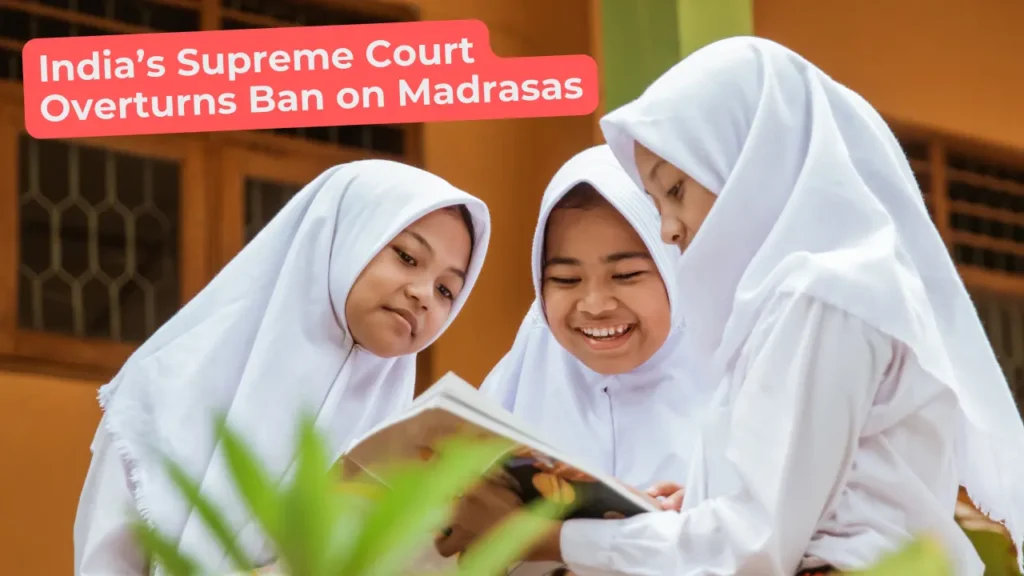In a landmark decision, India’s Supreme Court has overturned an order that banned Islamic schools, or madrasas, in the country’s most populous state, Uttar Pradesh. The ruling, delivered on Tuesday, provides relief to millions of students and teachers who were affected by the ban.
The Allahabad High Court had earlier scrapped the 2004 law governing madrasas, citing concerns over secularism and directing that students be transferred to conventional schools. However, the Supreme Court’s latest verdict allows 25,000 madrasas to continue operations, ensuring education for approximately 2.7 million students and employment security for 10,000 teachers.
Chief Justice D.Y. Chandrachud emphasized that the law governing madrasas aligns with the state’s responsibility to provide adequate education to children. “The act is consistent with the positive obligation of the state to ensure that the children get adequate education,” he stated in the court hearing.
The ruling comes amid broader concerns regarding the treatment of madrasas under Prime Minister Narendra Modi’s Bharatiya Janata Party (BJP)-led government. The BJP has been actively converting madrasas into conventional schools in Assam, sparking debates about the future of Islamic education in India.
The Importance of Madrasa Education in India
Madrasas have played a crucial role in the Indian education system for centuries, providing religious and secular education to Muslim students. These institutions offer courses in various subjects, including mathematics, science, literature, and Islamic studies. Many prominent scholars, educators, and community leaders have emerged from madrasa backgrounds, contributing significantly to India’s intellectual and social fabric.
For many underprivileged Muslim families, madrasas serve as the only accessible educational institutions, offering free or low-cost education, boarding, and meals. The recent ban in Uttar Pradesh had raised serious concerns about the future of these students, as transferring to conventional schools could pose financial and social challenges for them. The Supreme Court’s decision thus ensures continuity in their education and preserves their right to religious instruction.
The Legal and Constitutional Perspective
The Supreme Court’s decision to restore madrasas aligns with India’s constitutional commitment to religious freedom and the right to education. Article 30 of the Indian Constitution grants minorities the right to establish and administer educational institutions of their choice. The Allahabad High Court’s ruling, which sought to replace madrasa education with conventional schooling, was seen by many as an overreach that disregarded this constitutional safeguard.
Legal experts argue that education policies should aim for inclusivity rather than exclusion. By overturning the ban, the Supreme Court has reinforced the principle that the state must accommodate diverse educational traditions within a secular framework.
Political Reactions and Implications
The Supreme Court’s decision has drawn mixed reactions from political parties and social organizations. Muslim leaders and rights groups have welcomed the ruling, describing it as a victory for religious freedom and minority rights. They argue that targeting madrasas under the guise of promoting secularism undermines India’s pluralistic ethos.
Conversely, some BJP leaders have expressed disappointment, maintaining that conventional education should be prioritized over religious schooling. The government of Uttar Pradesh has yet to issue an official statement, but sources indicate that it may explore alternative measures to regulate madrasa education.
The Broader Context: Education Reforms and Minority Rights
The debate over madrasa education is part of a larger discourse on education reforms and minority rights in India. While the government has taken steps to modernize madrasa curricula by incorporating subjects such as English, science, and technology, concerns persist about the marginalization of Muslim educational institutions.
Several states have introduced measures to monitor madrasa activities, citing security concerns and the need for standardized education. However, critics argue that such policies often stem from political biases rather than genuine educational objectives. The challenge lies in striking a balance between modernizing education and preserving cultural and religious identities.
The Way Forward
With the Supreme Court’s ruling providing temporary relief, the focus must now shift toward constructive dialogue between the government, educational institutions, and community leaders. A collaborative approach can help address concerns about madrasa education while ensuring that students receive a well-rounded education that prepares them for the modern workforce.
One possible solution is the integration of modern subjects into madrasa curricula without compromising their religious teachings. Initiatives such as vocational training, digital literacy programs, and government support for infrastructure development can enhance the quality of education in these institutions.
Conclusion
The Supreme Court’s decision to overturn the ban on madrasas in Uttar Pradesh marks a significant moment in India’s ongoing struggle to balance religious freedoms with secular governance. It reaffirms the constitutional rights of minorities while highlighting the importance of inclusive education policies.
As India continues to evolve as a diverse and democratic nation, it is imperative to foster an educational environment that respects cultural identities while equipping students with the skills they need to thrive. The ruling serves as a reminder that education should be a bridge to unity, not a tool for division.

I attained the title of Hafiz-e-Quran from Jamia Rahmania Bashir Hat, West Bengal. Building on this, in 2024, I earned the degree of Moulana from Jamia Islamia Arabia, Amruha, U.P. These qualifications signify my expertise in Quranic memorization and Islamic studies, reflecting years of dedication and learning.


